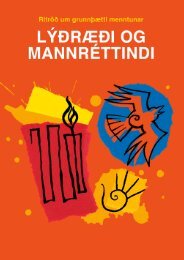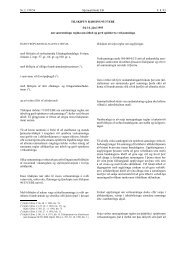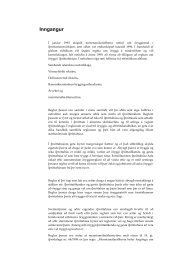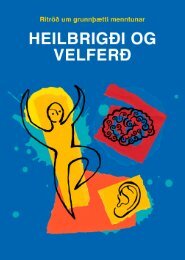Arts and Cultural Education in Iceland : Professor Anne Bamford
Arts and Cultural Education in Iceland : Professor Anne Bamford
Arts and Cultural Education in Iceland : Professor Anne Bamford
You also want an ePaper? Increase the reach of your titles
YUMPU automatically turns print PDFs into web optimized ePapers that Google loves.
We talk about art. I wish we could get coloured pr<strong>in</strong>ts form the gallery as we only have black <strong>and</strong> white<br />
photocopies. I tried to do colour copies on overhead transparencies, but they are not very good. The national<br />
Gallery used to have a service where you could borrow slides, but this service does not exist anymore.<br />
Comments from the art though also suggest that dem<strong>and</strong> for such services may be low, as<br />
the follow<strong>in</strong>g quote argues:<br />
The Reykjavik Art Museum is <strong>in</strong> three locations. There are about 10-12 thous<strong>and</strong> guests annually <strong>and</strong> roughly<br />
80% of these are under the age of 25. About 80% of the work <strong>in</strong> education department revolves around young<br />
people. The Art Museum, <strong>in</strong> cooperation with the <strong>Education</strong> department of the City of Reykjavík, have recently<br />
started a "roam<strong>in</strong>g" exhibit – a box that can be opened up, conta<strong>in</strong><strong>in</strong>g art works from the Museum, which travels<br />
between schools. Are teachers excited? Some are <strong>in</strong>terested – however, I've seen teachers go <strong>and</strong> have coffee<br />
dur<strong>in</strong>g class visitation. There is a big gap between what it says should be happen<strong>in</strong>g <strong>in</strong> the curriculum <strong>and</strong><br />
practice.<br />
At times a lack of consideration of practical processes was blamed for not encourag<strong>in</strong>g more<br />
partnership. For example, the national orchestra did not have weekend concerts <strong>and</strong> this made<br />
it impossible for more isolated communities to take advantage of br<strong>in</strong>g<strong>in</strong>g children to<br />
performances.<br />
Almost all the school pr<strong>in</strong>cipals <strong>in</strong>terviewed felt that the situation of partnership work<strong>in</strong>g<br />
was likely to get worse as a result of the f<strong>in</strong>ancial crisis. It was considered that the additional<br />
cost of br<strong>in</strong>g<strong>in</strong>g performers <strong>in</strong>to the school of tak<strong>in</strong>g children to performances would mean that<br />
these activities would cease. There was evidence that this was already occurr<strong>in</strong>g with many<br />
schools report<strong>in</strong>g that visits <strong>and</strong> excursions had been stopped as parents, the schools <strong>and</strong> the<br />
community could no longer afford these.<br />
There are very few examples of <strong>in</strong>dustry partnership <strong>in</strong> education <strong>in</strong> Icel<strong>and</strong>. Discussions<br />
regard<strong>in</strong>g <strong>in</strong>dustry support of a specialist arts secondary school were underway at the<br />
commencement of this research. But this proposal was not seen as be<strong>in</strong>g appropriate for the<br />
situation <strong>in</strong> Icel<strong>and</strong>.<br />
By contrast, some local organisations have managed to build highly successful partnerships<br />
by work<strong>in</strong>g very closely with schools <strong>and</strong> after school youth centres. These tended to be<br />
responsive organisations work<strong>in</strong>g very flexibly to meet the needs <strong>and</strong> <strong>in</strong>terests of their<br />
communities. The strength of local support is apparent <strong>in</strong> the follow<strong>in</strong>g vignette:<br />
Vignette 3.2.8 The local arts scene is very active<br />
The local arts scene is very active. It was argued that the small <strong>and</strong> close knit community supported the expansion of<br />
‘ground up’ arts <strong>in</strong>itiatives. Travell<strong>in</strong>g around the country, these are evident, with most members of the art<br />
community work<strong>in</strong>g <strong>in</strong> a range of paid <strong>and</strong> unpaid roles throughout the local community.<br />
For example, a s<strong>in</strong>gle performer ran the local amateur theatre, conducted a men’s choir <strong>and</strong> a choir of elderly people<br />
<strong>and</strong> ran a local choir festival – as well as teach<strong>in</strong>g the arts <strong>in</strong> schools. This sort of level of activity was not uncommon.<br />
Such local events were very well supported with on average 3,000-4,000 people attend<strong>in</strong>g but from Icel<strong>and</strong> <strong>and</strong><br />
<strong>in</strong>ternational visitors. Fund<strong>in</strong>g for such <strong>in</strong>itiatives tend to come from a number of sources, <strong>in</strong>clud<strong>in</strong>g local <strong>and</strong><br />
municipal government; local bus<strong>in</strong>ess; <strong>and</strong> <strong>in</strong>dividuals.<br />
These festivals probably generate significant value added economic wealth to a community through volunteer<br />
contributions <strong>and</strong> visitor <strong>and</strong> attendance figures. This is only conjecture though, as few of these local events gather<br />
robust figures on full economic cost<strong>in</strong>g, the value of <strong>in</strong>-k<strong>in</strong>d support <strong>and</strong>/or visitor data.<br />
There is an urgent need to ensure fund<strong>in</strong>g is provided to more fully measure, record <strong>and</strong> communicate the key<br />
learn<strong>in</strong>g <strong>and</strong> figures from such events <strong>and</strong> local <strong>in</strong>itiatives. This would appear to be a very timely recommendation as<br />
these local activities seem to be grow<strong>in</strong>g both <strong>in</strong> terms of frequency of events <strong>and</strong> number of attendees at events. For<br />
example, one regional music festival reported 300 visitors <strong>in</strong> the first year <strong>in</strong> 2000 <strong>and</strong> now has more than 5000<br />
60



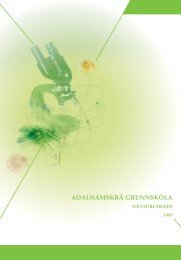
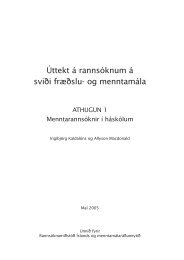

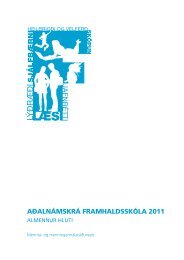
![Aðalnámskrá tónlistarskóla : rytmÃsk tónlist [Eingöngu á rafrænu formi]](https://img.yumpu.com/50843672/1/184x260/aaalnamskra-tanlistarskala-rytma-sk-tanlist-eingangu-a-rafranu-formi.jpg?quality=85)
